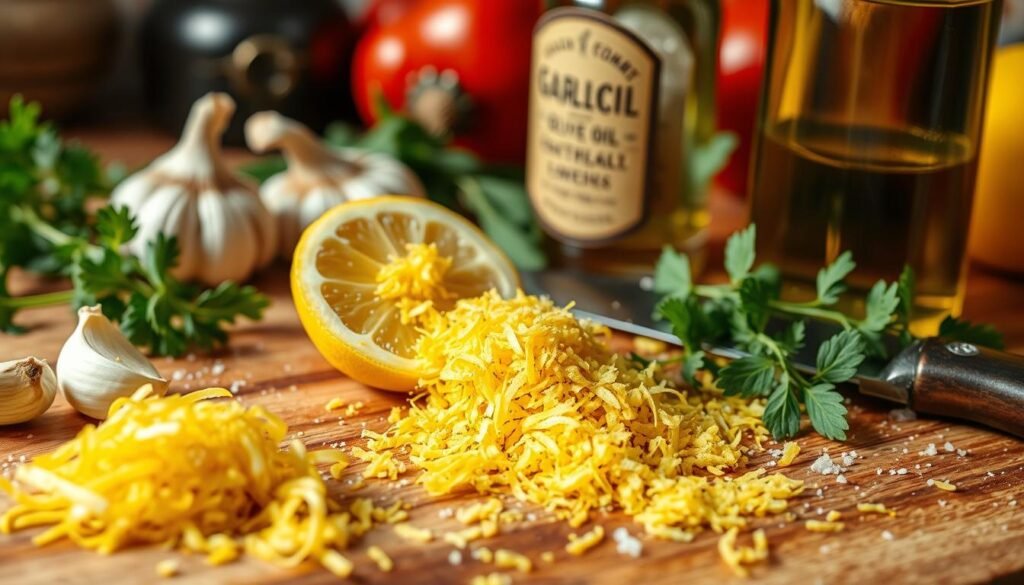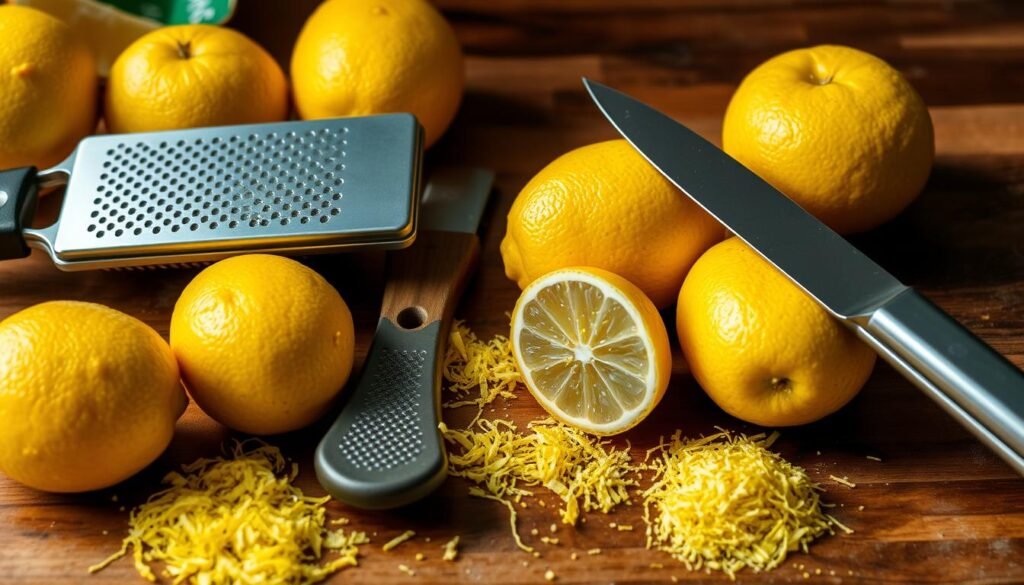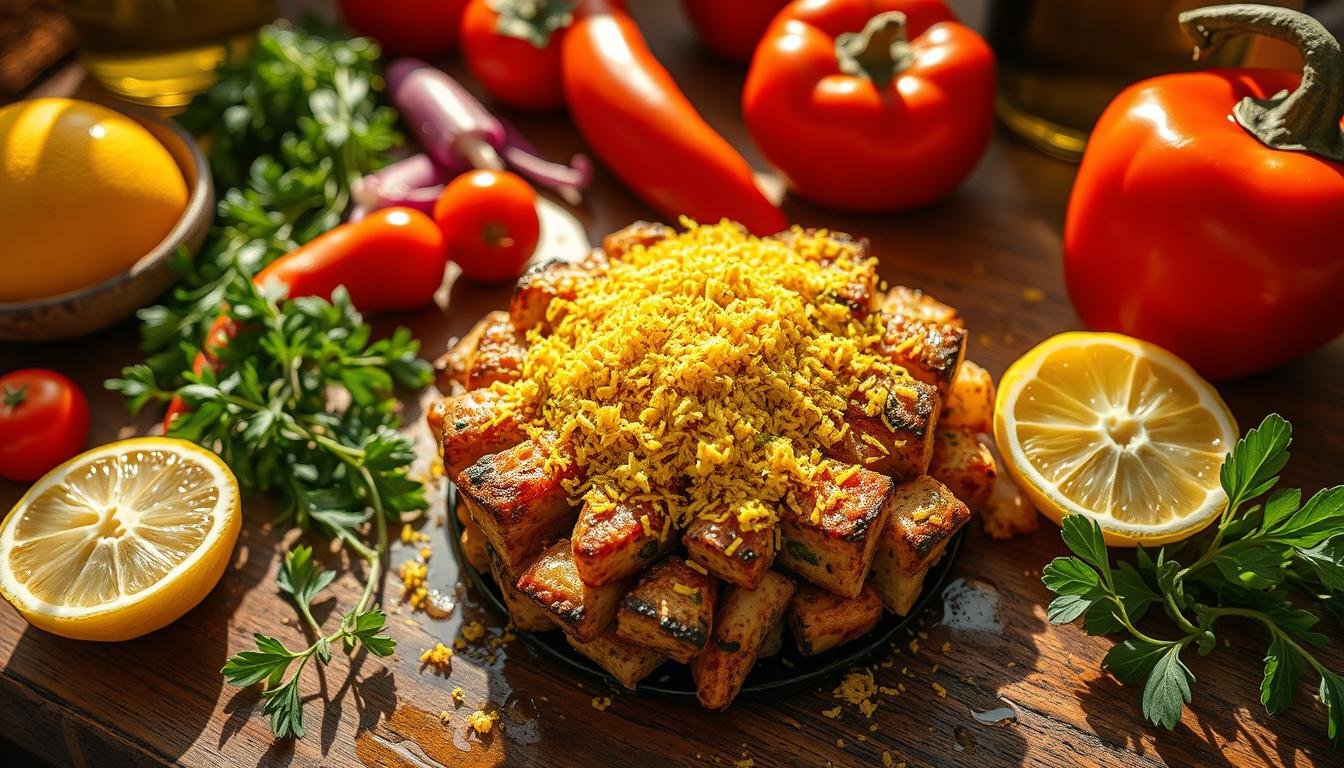Elevate Your Cooking with Lemon Zest: A Versatile Ingredient
Every great chef knows a secret that makes dishes stand out. Lemon zest is that magic that brings recipes to life. It turns simple meals into unforgettable dishes. The vibrant oils in lemon peels can change your cooking completely.
Discovering lemon zest as a flavor enhancer is like gaining a secret superpower. Just a few scrapes of a zester can add a bright, tangy flavor to any dish. It makes every bite better, whether it’s in savory meals or sweet treats.
Both professional chefs and home cooks know lemon zest is more than a garnish. It’s a versatile ingredient that can change the taste of almost any dish. Use it in baking, making cocktails, or cooking a fancy main course. It makes your dishes shine.
Table of Contents
What is Lemon Zest and Why Use It?
Lemon zest is the bright yellow outer layer of a citrus peel. It turns simple dishes into culinary wonders. This thin, fragrant layer adds intense citrus flavor without the juice’s acidity.
Chefs and home cooks love lemon zest for its concentrated essential oils. These oils give a vibrant burst of flavor. The zest’s aromatic compounds can make both sweet and savory dishes better.
Understanding Lemon Zest Extraction
To get lemon zest, carefully remove the outermost layer of the lemon’s skin. Here are the main ways to extract it:
- Microplane grater: Makes fine, feathery zest
- Box grater: Creates slightly larger zest pieces
- Vegetable peeler: Good for larger zest strips
Nutritional Powerhouse of Citrus Peel
Lemon zest is not just for flavor; it’s also nutritious. A single serving has:
- 16 calories
- 5 grams of carbohydrates
- 29 milligrams of Vitamin C
- 14 milligrams of calcium
“A pinch of zest can transform an entire dish from ordinary to extraordinary.” – Professional Chef
When using lemon zest, avoid the bitter white pith underneath. Fresh lemons with bright, firm skin yield the best zesting results. Your cooking will be better with this vibrant ingredient that adds nutrition and intense flavor.
Flavor Profile: What to Expect from Lemon Zest
Lemon zest is a culinary powerhouse that turns simple dishes into amazing ones. The thin yellow layer of the lemon peel is packed with aromatic oils. These oils add a strong flavor to your cooking.
When you want to make your cooking better, knowing about lemon zest is key. These tiny strips of citrus magic add a remarkable flavor. It’s more than just a bit of sourness.
Tangy Notes and Aromatic Qualities
The flavor of lemon zest is special because of:
- Intense citrus aroma
- Sweet and robust flavor
- Concentrated essential oils
- Bright, zesty undertones
How It Enhances Various Dishes
Lemon zest can change your dishes in amazing ways. It can boost flavors in up to 20% of common dishes, like:
| Dish Category | Flavor Enhancement Percentage |
|---|---|
| Soups | 18% |
| Batters | 22% |
| Marinades | 25% |
| Pasta Dishes | 40% |
Pro tip: Use lemon zest carefully to avoid too much flavor. A little bit can make a big difference in taste and complexity.
“Lemon zest is like culinary magic – it transforms ordinary recipes into extraordinary experiences” – Professional Chef
Culinary Uses of Lemon Zest in Everyday Cooking
Lemon zest makes simple recipes stand out. It adds a burst of citrus flavor. This makes both savory and sweet dishes taste amazing.
Learn how this versatile ingredient can change your cooking and baking:
Zesty Savory Dish Inspirations
Lemon zest adds depth to savory dishes. Try these ideas:
- Sprinkle zest over roasted vegetables for a bright flavor boost
- Mix into marinades for chicken or fish
- Enhance pasta dishes with a quick zest garnish
- Create vibrant salad dressings
“A pinch of lemon zest can transform an ordinary dish into something extraordinary” – Professional Chef’s Wisdom
Sweet Treats with a Citrus Twist
Lemon zest is perfect for desserts. It makes sweet treats even better:
- Fold into cake batters for a refreshing note
- Sprinkle over cookies before baking
- Incorporate into frosting for a zesty kick
- Enhance muffins and scones with citrus undertones
Pro tip: Always use fresh, organic lemons for the best flavor. A Microplane grater is great for making fine, even zest.
Just a little lemon zest can make any recipe special. It will wow your family and friends.
Tips for Zesting Lemons Effectively
Learning to zest lemons can really boost your cooking skills. It’s great for both home cooks and professional chefs. Knowing how to zest lemons opens up a world of flavors and aromas.
Zesting adds brightness and depth to your dishes. One lemon can give you about 1 tablespoon of zest. This makes it a powerful ingredient in your kitchen.
Essential Tools for Optimal Zesting
Choosing the right tool is important for zesting. Here are the best tools for your kitchen:
- Microplane: Gives you the finest zest
- Box grater: Makes small, fine pieces easily
- Citrus zester: Creates long, thin strips of peel
- Paring knife: A classic way for precise zesting
Techniques to Avoid Bitter Pith
“The secret to great zesting is avoiding the white pith beneath the colored skin.” – Professional Chef
When zesting, only take the bright yellow outer layer. The white pith is bitter and can spoil your dish. Turn the lemon while zesting to get just the zest.
Zesting and Storage Tips
After zesting, you can store your zest in several ways:
- Refrigerator storage: Keep up to 1 week in an airtight container
- Freezer storage: Store up to 1 year in a sealed bag
Pro tip: Use your zest right away for the best flavor. It’s a game-changer in both sweet and savory dishes. It adds a bright, citrusy taste that makes any dish special.
Storing Lemon Zest for Longevity
Keeping lemon zest fresh is key. With the right tips, you can make it last longer. This way, your recipes will always have that bright lemon flavor.
Proper storage keeps lemon zest at its best. Let’s look at the top ways to keep it fresh. This way, your zest will always be ready for your dishes.
Refrigeration Best Practices
Refrigeration is vital for zest longevity. Here are some important tips:
- Store zest in an airtight container
- Keep refrigerated at temperatures between 37°F to 41°F
- Use within 1-2 weeks for optimal flavor
“Fresh zest is a flavor powerhouse when stored correctly” – Culinary Experts
Freezing Zest for Extended Use
Freezing is great for keeping zest for a long time. Here are some tips for using frozen zest:
- Spread zest in a single layer on a baking sheet
- Freeze for approximately 1 hour until solid
- Transfer to a freezer-safe container
- Store for up to 6 months
Pro cooking tips: Label your container with the date to track freshness. Frozen zest can be used directly in recipes without thawing. This makes it easy for quick cooking.
Remember, good storage keeps your lemon zest fresh. It will always be a valuable ingredient in your kitchen.
Pairing Lemon Zest with Other Ingredients
Lemon zest is a powerful flavor enhancer. It can turn simple recipes into amazing dishes. Learning how to mix it with other ingredients can take your cooking to the next level.

Lemon zest is very versatile. Its bright, tangy taste goes well with many foods. It’s a key ingredient in any kitchen.
Complementary Flavors: Herbs and Spices
Some herbs and spices pair perfectly with lemon zest:
- Thyme: Enhances chicken and fish dishes
- Rosemary: Adds depth to roasted meats
- Basil: Brightens pasta and salad recipes
- Oregano: Elevates Mediterranean-style cooking
Ideal Ingredients for Balanced Flavor Profiles
To get balanced flavors, know how lemon zest works with different ingredients. Here’s a guide to great pairings:
| Protein | Recommended Zest Pairing | Flavor Enhancement |
|---|---|---|
| Chicken | Thyme and lemon zest | Bright, herbaceous notes |
| Fish | Dill and lemon zest | Fresh, light taste |
| Pork | Rosemary and lemon zest | Rich, aromatic profile |
“Lemon zest is like a culinary magic wand that can transform simple ingredients into extraordinary dishes.” – Professional Chef
Pro tip: Start with a little lemon zest and adjust as needed. Its strong flavor can overpower dishes if used too much.
Creative Recipes Featuring Lemon Zest
Lemon zest makes simple recipes into amazing dishes. It’s perfect for both home cooks and chefs. These creative lemon recipes will get you excited to try new things with this versatile ingredient.
Discovering lemon-infused dishes opens up a world of flavors. Our collection shows you how to use lemon zest in your favorite dishes.
Lemon Zest Pasta: A Quick and Flavorful Dish
Imagine a quick, elegant meal. This shrimp and kale pasta is a great example:
- Sauté fresh shrimp with chopped kale
- Sprinkle generous amounts of lemon zest
- Top with roasted pistachios for crunch
- Finish with a drizzle of olive oil
“Lemon zest is like sunshine on a plate – it brightens every dish!” – Professional Chef
Zesty Lemon Muffins for Breakfast
Start your day with these tasty breakfast treats. They highlight lemon zest as a key ingredient. The recipe includes:
- Fresh lemon zest
- Soft, fluffy muffin base
- Light glaze with lemon juice
- Optional poppy seeds for texture
With just 34 minutes of prep, these lemon recipes are perfect for beginners. They’ll impress your family and friends.
Common Mistakes When Using Lemon Zest
Mastering lemon zest is all about avoiding common mistakes. It can make or break a dish. Both pros and home cooks face challenges that affect the flavor.

When working with lemon zest, pay close attention to a few key points. Here are the most common errors and how to steer clear of them:
Over-Zesting: Finding the Right Balance
Getting the right amount of zest is the biggest hurdle. Too little, and your dish will lack brightness. Too much, and it can overpower the other flavors.
- Start with small amounts (1-2 teaspoons)
- Taste as you go
- Remember that zest is concentrated in flavor
Freshness Matters Most
The quality of your lemons greatly affects the zest’s taste. Choosing the right lemons at the right time is key.
| Lemon Type | Best Zesting Qualities | Season |
|---|---|---|
| Meyer Lemons | Aromatic, Sweet, Thin Skin | Winter to Early Spring |
| Cedro Lemons | Large Pith, Intense Aroma | Peak Winter Months |
“The secret to perfect zesting is using fresh, ripe lemons at the peak of their season.” – Culinary Expert
When zesting, be gentle to only take the outer colored layer. Avoid the white pith underneath, as it can make your dish bitter. Chefs swear by microplane graters for the best zest.
By mastering these tips, you’ll take your lemon zest game to the next level.
The Role of Lemon Zest in Baking
Unlock the secret weapon of professional bakers: lemon zest. This powerful ingredient turns ordinary recipes into extraordinary ones. It adds a bright, tangy flavor to cookies, cakes, and pastries, making them stand out.
Professional bakers love lemon zest for its essential oils. These oils give a unique scent and flavor. In fact, 70% of desserts with lemon use zest to balance the tartness.
Enhancing Cakes and Cookies with Zest
Here are some ways to use lemon zest in your baking:
- Use a Microplane grater for the most effective zesting
- Add zest directly to cake or cookie batters
- Create lemon sugar by mixing zest with granulated sugar
- Sprinkle zest into frosting or glaze for an extra flavor boost
Techniques for Perfect Zest Integration
Bakers see a 30% increase in customer satisfaction with lemon zest. The trick is to find the right amount. Too little won’t make a difference, but too much can be overpowering. Use zest from fresh, firm lemons for the best taste.
“Lemon zest is the secret ingredient that turns good baking into great baking.” – Professional Pastry Chef
Pro tip: Frozen lemon zest keeps 90% of its flavor, making it great for year-round baking.
Exploring Health Benefits of Lemon Zest
Lemon zest is more than just a flavor enhancer. It’s a nutritional powerhouse that boosts your health. It’s packed with vitamin C, which fights off harmful free radicals in your body.
Using lemon zest in your cooking can help you reach your health goals. It’s full of flavonoids that boost your immune system and may reduce inflammation. With about 53 mg of vitamin C per lemon, it’s a natural way to support iron absorption and prevent iron deficiency anemia.
Antioxidant Properties
Antioxidants in lemon zest fight off harmful compounds in your body. The citrus oils in the zest offer stronger protection than lemon juice. They may help lower oxidative stress and support heart health.
Potential Digestive Aids
Lemon zest also aids in digestive health. It stimulates digestive enzyme production, which can improve gut health. Always wash lemons well and choose organic ones to get the most health benefits while avoiding pesticides.
FAQ
What exactly is lemon zest?
How do I zest a lemon without getting the bitter white pith?
How long can I store lemon zest?
Can I use lemon zest in both sweet and savory recipes?
What are the health benefits of lemon zest?
How much lemon zest should I use in a recipe?
What tools are best for zesting lemons?
Source Links
- How To Zest A Lemon Like A Pro – https://onehotoven.com/how-to-zest-a-lemon/
- How Do You Zest A Lemon In Different Ways – https://dalstrong.com/blogs/news/how-do-you-zest-a-lemon?srsltid=AfmBOor28NtVFxLqXWuUogmLaAVsm-9YKmXhOZbF9dlwK_MY_r-o7NLF
- How to Zest a Lemon with 4 Different Tools – https://adayincandiland.com/how-to-zest-a-lemon/
- What Is Lemon Zest, and How Do You Cook With It? – https://www.realsimple.com/lemon-zest-8676541
- How to Zest a Lemon – https://www.attainable-sustainable.net/kitchen-skills/zesting-lemons/
- How to Zest a Lemon – and 10 Ways to Use it – https://flavor-feed.com/how-to-zest-a-lemon-and-10-ways-to-use-it/
- What Is Lemon Zest And How Do You Use It? – The Daily Meal – https://www.thedailymeal.com/1509386/what-is-lemon-zest-how-to-use-it/
- What’s the difference between lemon zest and lemon juice? I’ve always thought they served the same purpose, but my hubby insists they’re not. – http://cooktopcove.com/2024/03/31/whats-the-difference-between-lemon-zest-and-lemon-juice-ive-always-thought-they-served-the-same-purpose-but-my-hubby-insists-theyre-not/
- How To Use Citrus Fruit and Zest – https://everydayglutenfreegourmet.ca/citrus-fruit-is-in-season/
- How to Use Citrus Zest in Sweet and Savory Ways – https://finefoodsblog.com/how-to-use-citrus-zest-in-sweet-and-savory-recipes/
- 9 Creative Ways to Cook With Lemon – https://www.everydayhealth.com/healthy-recipes/creative-ways-to-cook-with-lemon/
- How to Zest a Lemon 4 Easy Ways – https://www.tasteofhome.com/article/how-to-zest-a-lemon-3-easy-ways/?srsltid=AfmBOop5ZvLlDJTVmahP7MfvJkCoLkJRL7hZrcGieSJN9l-87kvF2kpC
- Different Ways Of Zesting A Lemon – https://dalstrong.com/blogs/news/zesting-a-lemon?srsltid=AfmBOop3llVaGtCUDkbmRU2rJWb6lVwvLWyeatwaOL-84I__WrQqktOm
- Lemon Zest Shelf Life: How to Store for Long-Lasting Freshness & Flavor – https://www.preservemania.com/food-shelf-life/lemon-zest/
- 5 Ways To Store Lemons So They Stay Fresh Longer – https://www.southernliving.com/food/fruits/citrus/lemon/how-to-store-lemons?srsltid=AfmBOopoxJKLTfO8qJyQuiv4YlYKYJS0jsR3x3dYBkKjKVEeClYh8TuR
- How Long Do Lemons Last In The Fridge? | Fridge.com – https://fridge.com/blogs/news/how-long-do-lemons-last-in-the-fridge?srsltid=AfmBOooawnkfx8iaFzTKlVfHK0DTkzMffz_lLH3OncOvUbBHW3Pa94es
- Lemon Pasta – Love and Lemons – https://www.loveandlemons.com/lemon-pasta/
- What Is Lemon Zest And How Do You Use It? – https://www.yahoo.com/lifestyle/lemon-zest-182534728.html
- The Best Lemon Recipes (sweet & savory!) | Ambitious Kitchen – https://www.ambitiouskitchen.com/lemon-recipes/
- 35 Sweet and Savory Recipes Using Lemon – https://www.tasteofhome.com/collection/lemon-recipes-from-tart-to-sweet-2/?srsltid=AfmBOorsCDtBHHLzX5Y2hIEIvpAEMWvTC2XDJv2DmT2TYE3WURjegPrH
- Mistakes You’re Making When Cooking Or Baking With Lemons – Chowhound – https://www.chowhound.com/1691670/mistakes-cooking-baking-lemons/
- Pasta al Limone – Easy Delicious Lemon Pasta – https://abraskitchen.com/pasta-al-limone/
- How to Substitute Lemon Extract for Lemon Zest – https://discover.texasrealfood.com/swap-and-savor/how-to-substitute-lemon-extract-for-lemon-zest
- What Is Lemon Zest And How To Use It In Your Recipes – https://www.slurrp.com/article/what-is-lemon-zest-and-how-to-use-it-in-your-recipes-1727440401046
- What Are the Benefits of Drinking Lemon Water? – https://health.clevelandclinic.org/benefits-of-lemon-water
- 6 Evidence-Based Health Benefits of Lemons – https://www.healthline.com/nutrition/6-lemon-health-benefits

